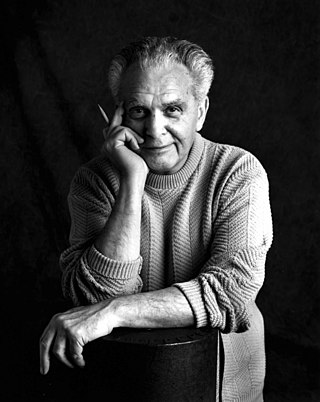
Jack Kirby was an American comic book artist, widely regarded as one of the medium's major innovators and one of its most prolific and influential creators. He grew up in New York City and learned to draw cartoon figures by tracing characters from comic strips and editorial cartoons. He entered the nascent comics industry in the 1930s, drawing various comics features under different pen names, including Jack Curtiss, before ultimately settling on Jack Kirby. In 1940, he and writer-editor Joe Simon created the highly successful superhero character Captain America for Timely Comics, predecessor of Marvel Comics. During the 1940s, Kirby regularly teamed with Simon, creating numerous characters for that company and for National Comics Publications, later to become DC Comics.

Christopher S. Claremont is an American comic book writer and novelist, known for his 16-year stint on Uncanny X-Men from 1975 to 1991, far longer than that of any other writer, during which he is credited with developing strong female characters as well as introducing complex literary themes into superhero narratives, turning the once underachieving comic into one of Marvel's most popular series.
Image Comics is an American comic book publisher and is the third-largest direct market comic book and graphic novel publisher in the industry by market share.

Fantagraphics is an American publisher of alternative comics, classic comic strip anthologies, manga, magazines, graphic novels, and the erotic Eros Comix imprint.

Peter Bagge is an American cartoonist whose best-known work includes the comics Hate and Neat Stuff. His stories often use black humor and exaggerated cartooning to dramatize the reduced expectations of middle-class American youth. He won two Harvey Awards in 1991, one for best cartoonist and one for his work on Hate. In recent decades Bagge has done more fact-based comics, everything from biographies to history to comics journalism. Publishers of Bagge's articles, illustrations, and comics include suck.com, MAD Magazine, toonlet, Discover, and the Weekly World News, with the comic strip Adventures of Batboy. He has expressed his libertarian views in features for Reason.
The Jack Kirby Comics Industry Awards were a set of awards for achievement in comic books, presented from 1985-1987. Voted on by comic-book professionals, the Kirby awards were the first such awards since the Shazam Awards ceased in 1975. Sponsored by Amazing Heroes magazine, and managed by Amazing Heroes managing editor Dave Olbrich, the Kirby Awards were named after the pioneering writer and artist Jack Kirby.

Jim Lee is a Korean American comic-book artist, writer, editor, and publisher. He is currently the President, Publisher and Chief Creative Officer of DC Comics. In recognition of his work, Lee has received a Harvey Award, Inkpot Award and three Wizard Fan Awards.
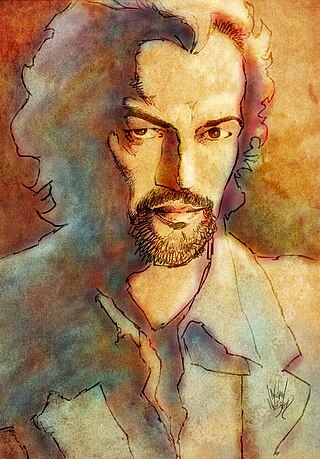
Barry Windsor-Smith is a British comic book illustrator and painter whose best-known work has been produced in the United States. He attained note working on Marvel Comics' Conan the Barbarian from 1970 to 1973, and for his work on the character Wolverine, particularly the 1991 "Weapon X" story arc. His other noted Marvel work included a 1984 "Thing" story in Marvel Fanfare, the "Lifedeath" and "Lifedeath II" stories with writer Chris Claremont that focused on the de-powered Storm in The Uncanny X-Men, as well as the 1984 Machine Man limited series with Herb Trimpe and Tom DeFalco.
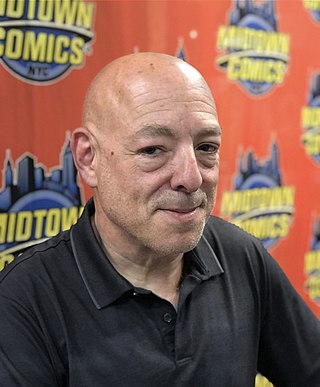
Brian Michael Bendis is an American comic book writer and artist.

Amazing Heroes was a magazine about the comic book medium published by American company Fantagraphics Books from 1981 to 1992. Unlike its companion title, The Comics Journal, Amazing Heroes was a hobbyist magazine rather than an analytical journal.

Malibu Comics Entertainment, Inc. was an American comic book publisher active in the late 1980s and early 1990s, best known for its Ultraverse line of superhero titles. Notable titles published by Malibu included The Men in Black, Ultraforce, and Night Man.

Eclipse Comics was an American comic book publisher, one of several independent publishers during the 1980s and early 1990s. In 1978, it published the first graphic novel intended for the newly created comic book specialty store market. It was one of the first to offer royalties and creator ownership of rights.

Youngblood is a superhero team that starred in their self-titled comic book, created by writer/artist Rob Liefeld. The team made its debut as a backup feature in RAMM #1 before the next month appearing in the one-shot Megaton Explosion #1 before later appearing in April 1992 in its own ongoing series as the flagship publication for Image Comics. Youngblood was originally published by Image Comics, and later by Awesome Entertainment. Upon Rob Liefeld's return to Image Comics, it was revived in 2008, 2012, and 2017. In 2019, Liefeld revealed that he has not owned the rights to Youngblood for several years.
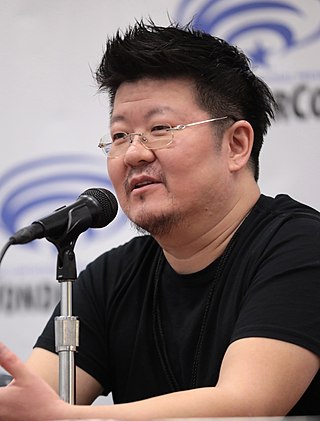
Jae Lee is a Korean American comics artist known for his interior illustration and cover work for various publishers, including Marvel Comics, DC Comics, Image Comics, and Dynamite Entertainment.

Jim Valentino is an American writer, penciler, editor and publisher of comic books, best known for his 1990–1992 work on Guardians of the Galaxy for Marvel Comics, and for co-founding Image Comics, a company publishing creator-owned comics.
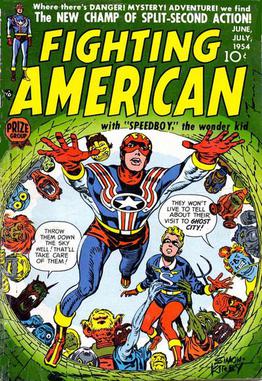
Fighting American is a superhero created in 1954 by the writer-artist team of Joe Simon and Jack Kirby. Published by the Crestwood Publications imprint Prize Comics, it was, contrary to standard industry practices of the time, creator-owned. Harvey Comics published one additional issue in 1966. One final inventoried tale was published in 1989, in a Marvel Comics hardcover collection of all the Fighting American stories.
In the United States, creator ownership in comics is an arrangement in which the comic book creator retains full ownership of the material, regardless of whether the work is self-published or published by a corporate publisher.
Scott Mitchell Rosenberg is an American film, television, and comic book producer. He is the chairman of Platinum Studios, an entertainment company that controls a library of comic-book characters and adapts them for film, television and other media. Through Platinum Studios he is affiliated with Moving Pictures Media Group. He is also the founder and former president of Malibu Comics, and is a former senior executive vice president for Marvel Comics.
The Creator's Bill of Rights is a document drafted in November 1988 by a number of independent comic book artists, writers, and publishers, designed to protect their rights as creators and publishers and oppose exploitation by corporate work for hire practices and the power of distributors to dictate the means of distribution. Issues covered by the Bill included giving creators proper credit for their characters and stories, profit-sharing, distribution, fair contracts, licensing, and return of original artwork. The signing of the Bill spurred Cerebus creator and self-publisher Dave Sim and Teenage Mutant Ninja Turtles creators/self-publishers Kevin Eastman and Peter Laird to sell or continue selling collected volumes of their comics directly to readers via their periodic issues, rather than through direct market distributors selling the collections at comic book specialty shops. Comic book professionals that have commented on the Bill conclude that it had little or no impact on the comic book industry.
Eric Stephenson is an American comic book publisher, editor, and writer. He is the publisher of Image Comics, where he has also co-created and written comics such as Long Hot Summer, Nowhere Men, and They're Not Like Us.














